Insights into the Molecular Basis of Huanglongbing Tolerance in Persian Lime (Citrus latifolia Tan.) through a Transcriptomic Approach
Abstract
1. Introduction
2. Results
2.1. Visual Symptoms and Confirmation of the Presence of CLas by RT-qPCR Analysis
2.2. Results from the Assembly of the Transcriptome from Persian Lime
2.3. Identification of Differentially Expressed Genes between HLB-Asymptomatic and HLB-Symptomatic Persian Lime Plants
2.4. Functional Classification of DEGs Found in HLB-Symptomatic Leaves
2.5. Gene Pathway Enrichment Analysis of Host Pathways in Response to CLas Infection
2.6. RT-qPCR Validation of DEGs from RNA-Seq Analysis
3. Discussion
4. Materials and Methods
4.1. Plant Material and Experimental Design
4.2. DNA Extraction and CLas Detection Persian Lime Leaves
4.3. Library Construction and Sequencing
4.4. Differential Expression Analysis and Transcriptome Annotation
4.5. Functional Classification by Gene Ontology (GO) and Assignment of Specific Metabolic Pathways
4.6. RNA Isolation and cDNA Synthesis
4.7. Gene Expression Validation
5. Conclusions
Supplementary Materials
Author Contributions
Funding
Institutional Review Board Statement
Informed Consent Statement
Data Availability Statement
Acknowledgments
Conflicts of Interest
References
- Méndez, J.M.A.; Caamal, V.J.H.; Rodríguez, A.N.L.; Vargas, D.A.A.; Alamilla, M.J.C.; Criollo, C.M.A. Avances y limitantes en la micropropagación del limón persa (Citrus × latifolia Tan.). Temas Cienc. Tecnol. 2020, 34, 33–40. [Google Scholar]
- SADER. Secretaría de Agricultura y Desarrollo Rural. Planeación Agrícola Citrícola Nacional. 2021. Available online: www.gob.mx/cms/uploads/attachment/file/257073/Potencial-C_tricos (accessed on 1 December 2022).
- SIAP. Servicio de Información Agroalimentaria y Pesquera. Datos Abiertos de México. Producción Anual Agrícola de Cítricos en México. 2020. Available online: https://datos.gob.mx/busca/organization/siap (accessed on 1 December 2022).
- Berdeja-Arbeu, R.; Gómez, M.; Méndez-Gómez, J.; Escobar-Hernández, R.; Pérez-Marroquín, G. Rendimiento y calidad de fruta de lima ‘Persa’ con nutrición química, estiércol y leguminosa en Martínez de la Torre, Veracruz, México. Investig. Cienc. Univ. Autónoma Aguascalientes 2019, 1, 44–50. [Google Scholar] [CrossRef]
- Navarro, L. Microinjerto de Ápices Caulinares In Vitro para la Obtención de Plantas de Agrios Libres de Virus. Bol. Serv. Plagas. 1979, 5, 127–148. Available online: https://redivia.gva.es/handle/20.500.11939/7363 (accessed on 1 December 2022).
- SENASICA. Servicio Nacional de Sanidad, Inocuidad y Calidad Agroalimentaria. SENASICA Protege el Cultivo de Cítricos en el País. 2018. Available online: https://www.gob.mx/senasica/articulos/senasica-protege-el-cultivo-de-citricos (accessed on 1 December 2022).
- Bové, J.M. Huanglongbing: A destructive, newly-emerging, century-old disease of citrus. J. Plant Pathol. 2006, 88, 7–37. [Google Scholar]
- Chien-Yu, H.; Araujo, K.; Niño-Sánchez, J.; Kund, G.; Trumble, J.; Roper, C.; Elvin-Godfrey, K.; Jin, H. A stable antimicrobial peptide with dual functions of treating and preventing citrus Huanglongbing. Proc. Natl. Acad. Sci. USA 2021, 118, e2019628118. [Google Scholar]
- Alquézar, B.; Carmona, L.; Bennici, S.; Peña, L. Engineering of citrus to obtain huanglongbing resistance. Curr. Opin. Biotechnol. 2021, 70, 196–203. [Google Scholar] [CrossRef]
- Achor, D.; Welker, S.; Ben-Mahmoud, S.; Wang, C.; Folimonova, S.Y.; Dutt, M.; Gowda, L.A. Dynamics of Candidatus Liberibacter asiaticus Movement and Sieve-Pore Plugging in Citrus Sink Cells. Plant Physiol. 2020, 182, 882–891. [Google Scholar] [CrossRef]
- Halbert, S.E.; Manjunath, K.L. Asian citrus psyllids (Sternorrhyncha: Psyllidae) and greening disease of citrus: A literature review and assessment of risk in Florida. Fla Entomol. 2004, 87, 330–353. [Google Scholar] [CrossRef]
- Grafton-Cardwell, E.E.; Stelinski, L.L.; Stansly, P.A. Biology and Management of Asian Citrus Psyllid, Vector of the Huanglongbing Pathogens. Annu. Rev. Entomol. 2013, 58, 413–432. [Google Scholar] [CrossRef]
- Alves, G.R.; Diniz, A.J.F.; Parra, J.R.P. Biology of the Huanglongbing vector Diaphorina citri (Hemiptera: Liviidae) on different host plants. J. Econ. Entomol. 2014, 107, 691–696. [Google Scholar] [CrossRef]
- Johnson, E.G.; Wu, J.; Bright, D.B.; Graham, J.H. Association of ‘Candidatus Liberibacter asiaticus’ root infection, but not phloem plugging with root loss on huanglongbing-affected trees prior to appearance of foliar symptoms. Plant Pathol. 2014, 63, 290–298. [Google Scholar] [CrossRef]
- Nwugo, C.C.; Duan, Y.; Lin, H. Study on citrus response to Huanglongbing highlights a down-regulation of defense-related proteins in lemon plants upon ‘Candidatus Liberibacter asiaticus’ Infection. PLoS ONE 2013, 8, e67442. [Google Scholar] [CrossRef] [PubMed]
- Pitino, M.; Armstrong, C.M.; Duan, Y. Molecular mechanisms behind the accumulation of ATP and H2O2 in citrus plants in response to ‘Candidatus Liberibacter asiaticus’ infection. Hortic. Res. 2017, 4, 17040. [Google Scholar] [CrossRef] [PubMed]
- Esquivel-Chávez, F.; Valdovinos-Ponce, G.; Mora-Aguilera, G.; Gómez-Jaimes, R.; Velázquez-Monreal, J.J.; Manzanilla-Ramírez, M.A.; Flores-Sánchez, J.L.; López-Arroyo, J.I. Histological analysis of sour citrus and sweet orange leaves with symptoms caused by Candidatus Liberibacter asiaticus. Agrociencia 2012, 46, 769–782. [Google Scholar]
- Marquez-Pérez, F.J.; Flores-Sánchez, J.L.; Rodríguez-Mejía, L.; Márquez-Gómez, J.; Michereff, S.J.; Ancona, V.; Robles-Bermúdez, A.; Domínguez-Monge, S. Progress and spatial pattern of huanglongbing in Persian lime in Nayarit, Mexico. Bio Cienc. 2018, 5, e351. [Google Scholar]
- Weber, K.C.; Mahmoud, L.M.; Stanton, D.; Welker, S.; Qiu, W.; Grosser, J.W.; Levy, A.; Dutt, M. Insights into the Mechanism of Huanglongbing Tolerance in the Australian Finger Lime (Citrus australasica). Front. Plant Sci. 2022, 13, 1019295. [Google Scholar] [CrossRef]
- Evans, E.A.; Ballen, F.H.; Crane, J.H. Economic Potential of Producing Tahiti Limes in Southern Florida in the Presence of Citrus Canker and Citrus Greening. Hort. Technol. 2014, 24, 99–106. [Google Scholar] [CrossRef]
- Sivager, G.; Calvez, L.; Bruyere, S.; Boisne-Noc, R.; Brat, P.; Gros, O.; Ollitrault, P.; Morillon, R. Specific Physiological and Anatomical Traits Associated with Polyploidy and Better Detoxification Processes Contribute to Improved Huanglongbing Tolerance of the Persian Lime Compared with the Mexican Lime. Front. Plant Sci. 2021, 12, 685679. [Google Scholar] [CrossRef]
- McCollum, G.; Hilf, M.; Irey, M.; Luo, W.; Gottwald, T. Susceptibility of Sixteen Citrus Genotypes to ‘Candidatus Liberibacter asiaticus’. Plant Dis. 2016, 100, 1080–1086. [Google Scholar] [CrossRef]
- Arce-Leal, Á.P.; Bautista, R.; Rodríguez-Negrete, E.A.; Manzanilla-Ramírez, M.Á.; Velázquez-Monreal, J.J.; Santos-Cervantes, M.E.; Méndez-Lozano, J.; Beuzón, C.R.; Bejarano, E.R.; Castillo, A.G.; et al. Gene Expression Profile of Mexican Lime (Citrus aurantifolia) Trees in Response to Huanglongbing Disease caused by Candidatus Liberibacter asiaticus. Microorganisms 2020, 8, 528. [Google Scholar] [CrossRef]
- Ma, W.; Pang, Z.; Huang, X.; Xu, J.; Pandey, S.S.; Li, J.; Achor, D.S.; Vasconcelos, F.N.C.; Hendrich, C.; Huang, Y.; et al. Citrus Huanglongbing is a pathogen-triggered immune disease that can be mitigated with antioxidants and gibberellin. Nat. Commun. 2022, 13, 529. [Google Scholar] [CrossRef] [PubMed]
- Li, T.; Zhang, L.; Deng, Y.; Deng, X.; Zheng, Z. Establishment of a Cuscuta campestris-mediated enrichment system for genomic and transcriptomic analyses of ‘Candidatus Liberibacter asiaticus’. Microb. Biotechnol. 2021, 14, 737–751. [Google Scholar] [CrossRef] [PubMed]
- Albrecht, U.; Bowman, K.D. Transcriptional response of susceptible and tolerant citrus to infection with Candidatus Liberibacter asiaticus. Plant Sci. 2012, 185, 118–130. [Google Scholar] [CrossRef] [PubMed]
- Qiu, W.; Soares, J.; Pang, Z.; Huang, Y.; Sun, Z.; Wang, N.; Grosser, J.; Dutt, M. Potential Mechanisms of AtNPR1 Mediated Resistance against Huanglongbing (HLB) in Citrus. Int. J. Mol. Sci. 2020, 21, 2009. [Google Scholar] [CrossRef]
- Van Loon, L.C.; Rep, M.; Pieterse, C.M.J. Significance of inducible defense-related proteins in infected plants. Annu. Rev. Phytopathol. 2006, 44, 135–162. [Google Scholar] [CrossRef] [PubMed]
- Pang, Z.; Zhang, L.; Coaker, G.; Ma, W.; Sheng-Yang, H.; Wang, N. Citrus CsACD2 Is a Target of Candidatus Liberibacter Asiaticus in Huanglongbing Disease. Plant Pysiol. 2020, 184, 792–805. [Google Scholar] [CrossRef] [PubMed]
- Fu, S.; Shao, J.; Zhou, C.; Hartung, J.S. Transcriptome analysis of sweet orange trees infected with “Candidatus Liberibacter asiaticus” and two strains of Citrus Tristeza Virus. BMC Genom. 2016, 11, 349. [Google Scholar] [CrossRef]
- Curtolo, M.; de Souza, P.I.; Pires, B.L.; Aurélio, T.M.; Moreira, G.L.; Manzano, G.D.; Alves de Souza, A.; Cristofani-Yaly, M.; Antonio, M.M. Wide-ranging transcriptomic analysis of Poncirus trifoliata, Citrus sunki, Citrus sinensis and contrasting hybrids reveals HLB tolerance mechanisms. Sci. Rep. 2020, 10, 20865. [Google Scholar] [CrossRef]
- Wang, Y.; Zhou, L.; Yu, X.; Stover, E.; Luo, F.; Duan, Y. Transcriptome profiling of Huanglongbing (HLB) tolerant and susceptible citrus plants reveals the role of basal resistance in HLB tolerance. Front. Plant Sci. 2016, 7, 933. [Google Scholar] [CrossRef] [PubMed]
- Hammond-Kosack, K.E.; Tang, S.; Harrison, K.; Jones, J.D.G. The tomato Cf-9 disease resistance gene functions in tobacco and potato to confer responsiveness to the fungal avirulence gene product avr 9. Plant Cell 1998, 10, 1251–1266. [Google Scholar] [CrossRef]
- Aritua, V.; Achor, D.; Gmitter, F.G.; Albrigo, G.; Wang, N. Transcriptional and Microscopic Analyses of Citrus Stem and Root Responses to Candidatus Liberibacter asiaticus Infection. PLoS ONE 2013, 8, e73742. [Google Scholar] [CrossRef]
- Chinchilla, D.; Bauer, Z.; Regenass, M.; Boller, T.; Felix, G. The Arabidopsis receptor kinase FLS2 binds flg22 and determines the specificity of flagellin perception. Plant Cell 2006, 18, 465–476. [Google Scholar] [CrossRef] [PubMed]
- Shi, Q.; Febres, V.J.; Zhang, S.; Yu, F.; McCollum, G.; Hall, D.G.; Moore, G.A.; Stover, E. Identification of Gene Candidates Associated with Huanglongbing Tolerance, Using ‘Candidatus Liberibacter asiaticus’ Flagellin 22 as a Proxy to Challenge Citrus. MPMI 2018, 31, 200–211. [Google Scholar] [CrossRef] [PubMed]
- Yu, Q.; Chen, C.; Du, D.; Huang, M.; Yao, J.; Yu, F.; Brlansky, R.H.; Gmitter, F.G., Jr. Reprogramming of a defense signaling pathway in rough lemon and sweet orange is a critical element of the early response to Candidatus Liberibacter asiaticus. Hortic. Res. 2017, 4, 17063. [Google Scholar] [CrossRef] [PubMed]
- Peng, T.; Kang, J.L.; Xiong, X.T.; Cheng, F.T.; Zhou, X.J.; Dai, W.S.; Wang, M.; Li, Z.Y.; Su, H.N.; Zhong, B.L. Integrated Transcriptomics and Metabolomics Analyses Provide Insights into the Response of Chongyi Wild Mandarin to Candidatus Liberibacter Asiaticus Infection. Front. Plant Sci. 2021, 12, 748209. [Google Scholar] [CrossRef]
- Andrade, M.O.; Pang, Z.; Achor, D.S.; Wang, H.; Yao, T.; Singer, B.H.; Wang, N. The flagella of ‘Candidatus Liberibacter asiaticus’ and its movement in planta. Mol. Plant Pathol. 2020, 21, 109–123. [Google Scholar] [CrossRef]
- Peng, H.; Chen, Z.; Fang, Z.; Zhou, J.; Xia, Z.; Gao, L.; Chen, L.; Li, L.; Li, T.; Zhai, W.; et al. Rice Xa21 primed genes and pathways that are critical for combating bacterial blight infection. Sci. Rep. 2015, 5, 12165. [Google Scholar] [CrossRef]
- Sun, L.; Nasrullah, K.F.; Nie, Z.; Wang, P.; Xu, J. Citrus Genetic Engineering for Disease Resistance: Past, Present and Future. Int. J. Mol. Sci. 2019, 20, 5256. [Google Scholar] [CrossRef]
- Omar, A.A.; Murata, M.M.; El-Shamy, H.A.; Graham, J.H.; Grosser, J.W. Enhanced resistance to citrus canker in transgenic mandarin expressing Xa21 from rice. Transgenic Res. 2018, 27, 179–191. [Google Scholar] [CrossRef]
- Pruitt, R.N.; Schwessinger, B.; Joe, A.; Thomas, N.; Liu, F.; Albert, M.; Robinson, M.R.; Chan, L.J.; Luu, D.D.; Chen, H.; et al. The rice immune receptor XA21 recognizes a tyrosine-sulfated protein from a Gram-negative bacterium. Sci. Adv. 2015, 1, e1500245. [Google Scholar] [CrossRef]
- Du, P.; Zhang, C.; Zou, X.; Zhu, Z.; Yan, H.; Wuriyanghan, H.; Li, W. “Candidatus Liberibacter asiaticus” Secretes Nonclassically Secreted Proteins That Suppress Host Hypersensitive Cell Death and Induce Expression of Plant Pathogenesis-Related Proteins. Appl. Environ. Microbiol. 2021, 12, e00019-21. [Google Scholar] [CrossRef] [PubMed]
- Zhong, Y.; Cheng, C.Z.; Jiang, N.H.; Jiang, B.; Zhang, Y.Y.; Wu, B.; Hu, M.L.; Zeng, J.W.; Yan, H.X.; Yi, G.J.; et al. Comparative transcriptome and iTRAQ proteome analyses of citrus root responses to Candidatus Liberibacter asiaticus Infection. PLoS ONE 2015, 10, e126973. [Google Scholar] [CrossRef] [PubMed]
- Mackey, D.; Holt, B.F., 3rd; Wiig, A.; Dangl, J.L. RIN4 interacts with Pseudomonas syringae type III effector molecules and is required for RPM1-mediated resistance in Arabidopsis. Cell 2002, 108, 743–754. [Google Scholar] [CrossRef]
- Cheng, C.; Zhong, Y.; Wang, B.; Zhang, Y.; Wu, H.; Jiang, N.; Wu, B.; Lv, Y.; Jiang, B. The Upregulated Expression of the Citrus RIN4 Gene in HLB Diseased Citrus Aids Candidatus Liberibacter Asiaticus Infection. Int. J. Mol. Sci. 2022, 23, 6971. [Google Scholar] [CrossRef] [PubMed]
- Day, B.; Dalhbeck, D.; Huang, J.; Chisholm, S.T.; Li, D.; Staskawickz, B.J. Molecular Basis for the RIN4 Negative Regulation of RPS2 Disease Resistance. Plant Cell. 2005, 17, 1292–1305. [Google Scholar] [CrossRef]
- Li, Z.; Huang, J.; Wang, Z.; Meng, F.; Zhang, S.; Wu, X.; Zhang, Z.; Gao, Z. Overexpression of Arabidopsis Nucleotide-Binding and Leucine-Rich Repeat Genes RPS2 and RPM1(D505V) Confers Broad-Spectrum Disease Resistance in Rice. Front. Plant Sci. 2019, 10, 417. [Google Scholar] [CrossRef]
- Bigeard, J.; Colcombet, J.; Hirt, H. Signaling mechanisms in pattern-triggered immunity (PTI). Mol. Plant 2015, 8, 521–539. [Google Scholar] [CrossRef]
- Yang, C.; Powell, C.; Duan, Y.; Lin, X.; Fan, G.; Hu, H.; Zhang, M. Key Role of Heat Shock Protein Expression Induced by Ampicillin in Citrus Defense against Huanglongbing: A Transcriptomics Study. Agronomy 2022, 12, 1356. [Google Scholar] [CrossRef]
- Xu, Z.S.; Li, Z.Y.; Chen, Y.; Chen, M.; Li, C.L.; Ma, Y.Z. Heat Shock Protein 90 in Plants: Molecular Mechanisms and Roles in Stress Responses. Int. J. Mol. Sci. 2012, 13, 15706–15723. [Google Scholar] [CrossRef]
- Wei, Y.; Zhu, B.; Liu, W.; Cheng, X.; Lin, D.; He, C.; Shi, H. Heat shock protein 90 co-chaperone modules fine-tune the antagonistic interaction between salicylic acid and auxin biosynthesis in cassava. Cell Rep. 2021, 34, 108717. [Google Scholar] [CrossRef]
- Di Donato, M.; Geisler, M. HSP90 and co-chaperones: A multitaskers’ view on plant hormone biology. FEBS Lett. 2019, 13, 1415–1430. [Google Scholar] [CrossRef] [PubMed]
- Suh, J.H.; Tang, X.; Zhang, Y.; Gmitter, F.G., Jr.; Wang, Y. Metabolomic Analysis Provides New Insight into Tolerance of Huanglongbing in Citrus. Front. Plant Sci. 2021, 12, 710598. [Google Scholar] [CrossRef] [PubMed]
- Gonzalez, P.; Reyes de Corcuera, J.; Etxeberria, E. Characterization of leaf starch from HLB-affected and unaffected-girdled citrus trees. Physiol. Mol. Plant Pathol. 2012, 79, 71–78. [Google Scholar] [CrossRef]
- Pitino, M.; Allen, V.; Duan, Y. LasΔ5315 Effector Induces Extreme Starch Accumulation and Chlorosis as Ca. Liberibacter asiaticus Infection in Nicotiana benthamiana. Front. Plant Sci. 2018, 9, 113. [Google Scholar] [CrossRef]
- Andriotis, V.M.E.; Saalbach, G.; Waugh, R.; Field, R.A.; Smith, A.M. The Maltase Involved in Starch Metabolism in Barley Endosperm Is Encoded by a Single Gene. PLoS ONE 2016, 11, e0151642. [Google Scholar] [CrossRef]
- Ceusters, N.; Frans, M.; Van den Ende, W.; Ceusters, J. Maltose Processing and Not β-Amylase Activity Curtails Hydrolytic Starch Degradation in the CAM Orchid Phalaenopsis. Front. Plant Sci. 2019, 10, 1386. [Google Scholar] [CrossRef]
- Grauvogel, C.; Brinkmann, H.; Petersen, J. Evolution of the glucose-6-phosphate isomerase: The plasticity of primary metabolism in photosynthetic eukaryotes. Mol. Biol. Evol. 2007, 24, 1611–1621. [Google Scholar] [CrossRef]
- Cui, L.; Xue, L.; Li, J.; Zhang, L.; Yan, H. Characterization of the glucose-6-phosphate isomerase (GPI) gene from the halotolerant alga Dunaliella salina. Mol. Biol. Rep. 2010, 37, 911–916. [Google Scholar] [CrossRef]
- Ibañez, A.M.; Martinelli, F.; Reagan, R.L.; Uratsu, S.L.; Vo, A.; Tinnoco, T.A.; Phu, M.L.; Chen, Y.; Rocke, D.M.; Dandekar, A.M. Transcriptome and metabolome analysis of Citrus fruit to elucidate puffing disorder. Pant Sci. 2014, 217–218, 87–98. [Google Scholar] [CrossRef]
- Fan, J.; Chen, C.; Brlansky, R.H.; Gmitter, F.G., Jr.; Li, Z.G. Changes in carbohydrate metabolism in Citrus sinensis infected with ‘Candidatus Liberibacter asiaticus’. Plant Pathol. 2010, 59, 1037–1043. [Google Scholar] [CrossRef]
- Granot, D.; David-Schwartz, R.; Kelly, G. Hexose kinases and their role in sugar-sensing and plant development. Front. Plant Sci. 2013, 4, 44. [Google Scholar] [CrossRef] [PubMed]
- Hu, Y.; Zhong, X.; Liu, X.; Lou, B.; Zhou, C.; Wang, X. Comparative transcriptome analysis unveils the tolerance mechanisms of Citrus hystrix in response to ‘Candidatus Liberibacter asiaticus’ infection. PLoS ONE 2017, 12, e0189229. [Google Scholar] [CrossRef] [PubMed]
- Wu, H.; Hu, Y.; Fu, S.; Zhou, C.; Wang, X. Coordination of multiple regulation pathways contributes to the tolerance of a wild citrus species (Citrus ichangensis ‘2586’) against Huanglongbing. Physiol. Mol. Plant Pathol. 2020, 109, 101457. [Google Scholar] [CrossRef]
- Yu, J.K.; Moon, Y.S. Corn Starch: Quality and Quantity Improvement for Industrial Uses. Plants 2022, 11, 92. [Google Scholar] [CrossRef] [PubMed]
- Shen, J.; Liu, J.; Yuan, Y.; Chen, L.; Ma, J.; Li, X.; Li, J. The mechanism of abscisic acid regulation of wild Fragaria species in response to cold stress. BMC Genom. 2022, 23, 670. [Google Scholar] [CrossRef]
- Flores-de la Rosa, F.R.; Santillán-Mendoza, R.; Rodríguez-Quibrera, C.G.; Martínez-Ruiz, A.; Adame-García, J.; Luna-Rodríguez, M. Antioxidant gene expression, chlorophyll, and starch content in Persian lime (Citrus latifolia Tanaka Ex Q. Jiménez) trees with HLB by application of elicitors of plant resistance. Mex. J. Biotech. 2021, 6, 86–102. [Google Scholar] [CrossRef]
- Luo, D.; Jia, Z.; Cheng, Y.; Zou, X.; Lv, Y. Genome-Wide Analysis of the β-Amylase Gene Family in Brassica L. Crops and Expression Profiles of BnaBAM Genes in Response to Abiotic Stresses. Agronomy 2020, 10, 1855. [Google Scholar] [CrossRef]
- Ribeiro, C.; Xu, J.; Teper, D.; Lee, D.; Wang, N. The transcriptome landscapes of citrus leaf in different developmental stages. Plant Mol. Biol. 2021, 106, 349–366. [Google Scholar] [CrossRef]
- Bao, M.; Zheng, Z.; Sun, X.; Chen, J.; Deng, X. Enhancing PCR Capacity to Detect ‘Candidatus Liberibacter asiaticus’ Utilizing Whole Genome Sequence Information. Plant Dis. 2020, 104, 527–532. [Google Scholar] [CrossRef]
- Grabherr, M.G.; Haas, B.J.; Yassour, M.; Levin, J.Z.; Thompson, D.A.; Amit, I.; Adiconis, X.; Fan, L.; Raychowdhury, R.; Zeng, Q.; et al. Full-length transcriptome assembly from RNA-Seq data without a reference genome. Nat. Biotech. 2011, 29, 644–652. [Google Scholar] [CrossRef]
- Gurevich, A.; Saveliev, V.; Vyahhi, N.; Tesler, G. QUAST: Quality assessment tool for genome assemblies. Bioinformatics 2013, 29, 1072–1075. [Google Scholar] [CrossRef] [PubMed]
- Langmead, B.; Salzberg, S.L. Fast gapped-read alignment with Bowtie 2. Nat. Methods 2012, 9, 357–359. [Google Scholar] [CrossRef] [PubMed]
- Li, B.; Dewey, C.N. RSEM: Accurate transcript quantification from RNA-Seq data with or without a reference genome. BMC Bioinform. 2012, 12, 323. [Google Scholar]
- Jiménez-Jacinto, V.; Sanchez-Flores, A.; Vega-Alvarado, L. Integrative differential expression analysis for multiple Experiments (IDEAMEX): A web server tool for integrated RNA-Seq data analysis. Front. Genet. 2019, 11, 1–16. [Google Scholar] [CrossRef] [PubMed]
- Love, M.I.; Huber, W.; Anders, S. Moderated estimation of fold change and dispersion for RNA-Seq data with DESeq2. Genome Biol. 2014, 15, 550. [Google Scholar] [CrossRef]
- Altschul, S.F.; Gish, W.; Miller, W.; Myers, E.W.; Lipman, D.J. Basic local alignment search tool. J. Mol. Biol. 1990, 215, 403–410. [Google Scholar] [CrossRef]
- Finn, R.D.; Clements, J.; Eddy, S.R. HMMER web server: Interactive sequence similarity searching. Nucleic Acids Res. 2011, 39, 29–37. [Google Scholar] [CrossRef]
- Finn, R.D.; Bateman, A.; Clements, J.; Coggill, P.; Eberhardt, R.Y.; Eddy, S.R.; Heger, A.; Hetherington, K.; Holm, L.; Mistry, J.; et al. Pfam: The protein families database. Nucleic Acids Res. 2014, 42, 222–230. [Google Scholar] [CrossRef]
- El-Gebali, S.; Mistry, J.; Bateman, A.; Eddy, S.R.; Luciani, A.; Potter, S.C.; Qureshi, M.; Richardson, L.J.; Salazar, G.A.; Smart, A.; et al. The Pfam protein families database in 2019. Nucleic Acids Res. 2019, 47, 427–432. [Google Scholar] [CrossRef]
- Mistry, J.; Chuguransky, S.; Williams, L.; Qureshi, M.; Salazar, G.A.; Sonnhammer, E.L.L.; Tosatto, S.C.E.; Paladin, L.; Raj, S.; Richardson, L.J.; et al. Pfam: The protein families database in 2021. Nucleic Acids Res. 2021, 49, 412–419. [Google Scholar] [CrossRef]
- Conesa, A.; Götz, S.; García-Gómez, J.M.; Terol, J.; Talón, M.; Robles, M. Blast2GO: A Universal Tool for Annotation, Visualization and Analysis in Functional Genomics Research. Bioinformatics 2005, 21, 3674–3676. [Google Scholar] [CrossRef] [PubMed]
- Schmittgen, T.D.; Livak, K.J. Analyzing real-time PCR data by the comparative C(T) method. Nat. Protoc. 2008, 3, 1101–1108. [Google Scholar] [CrossRef] [PubMed]
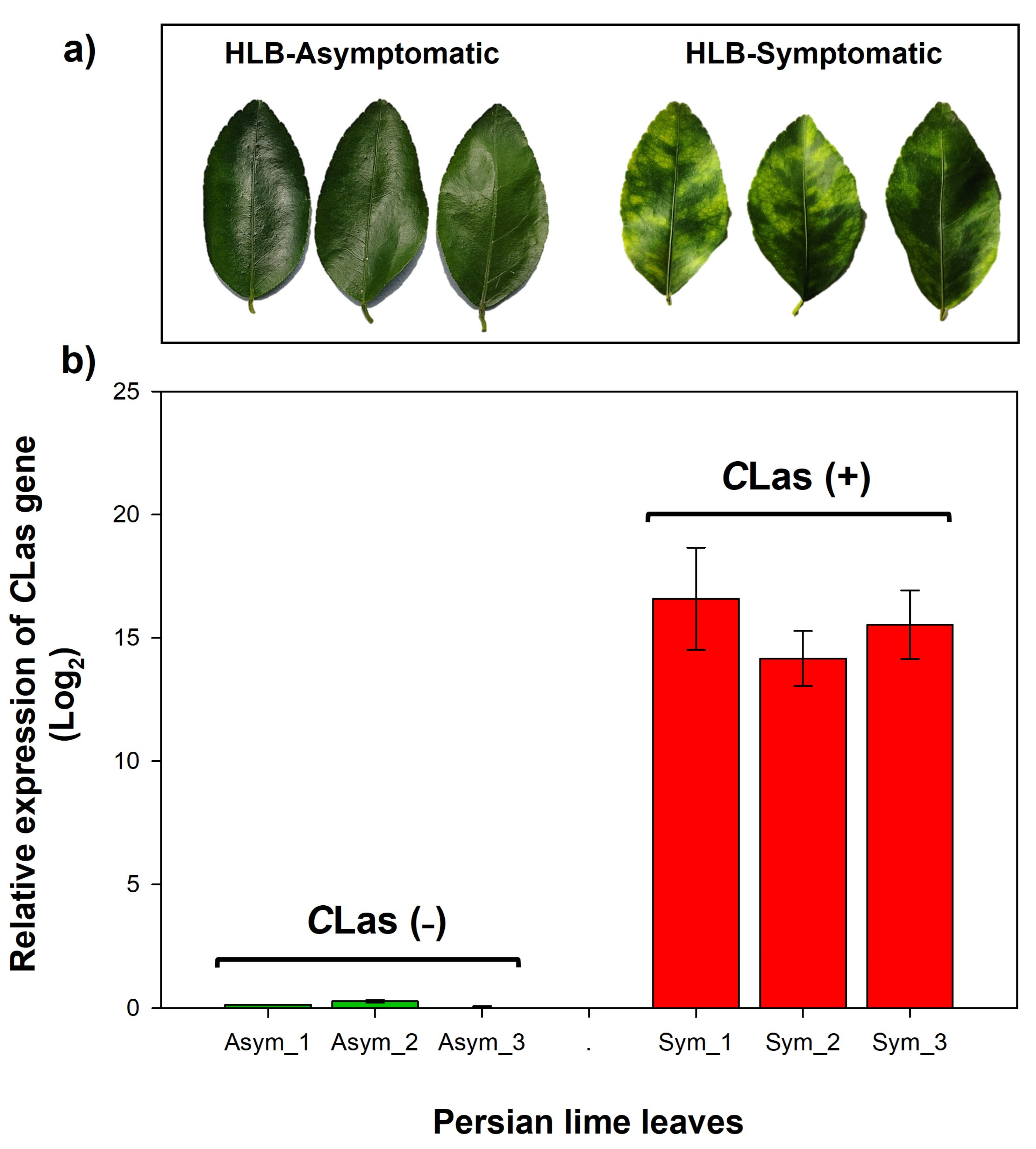
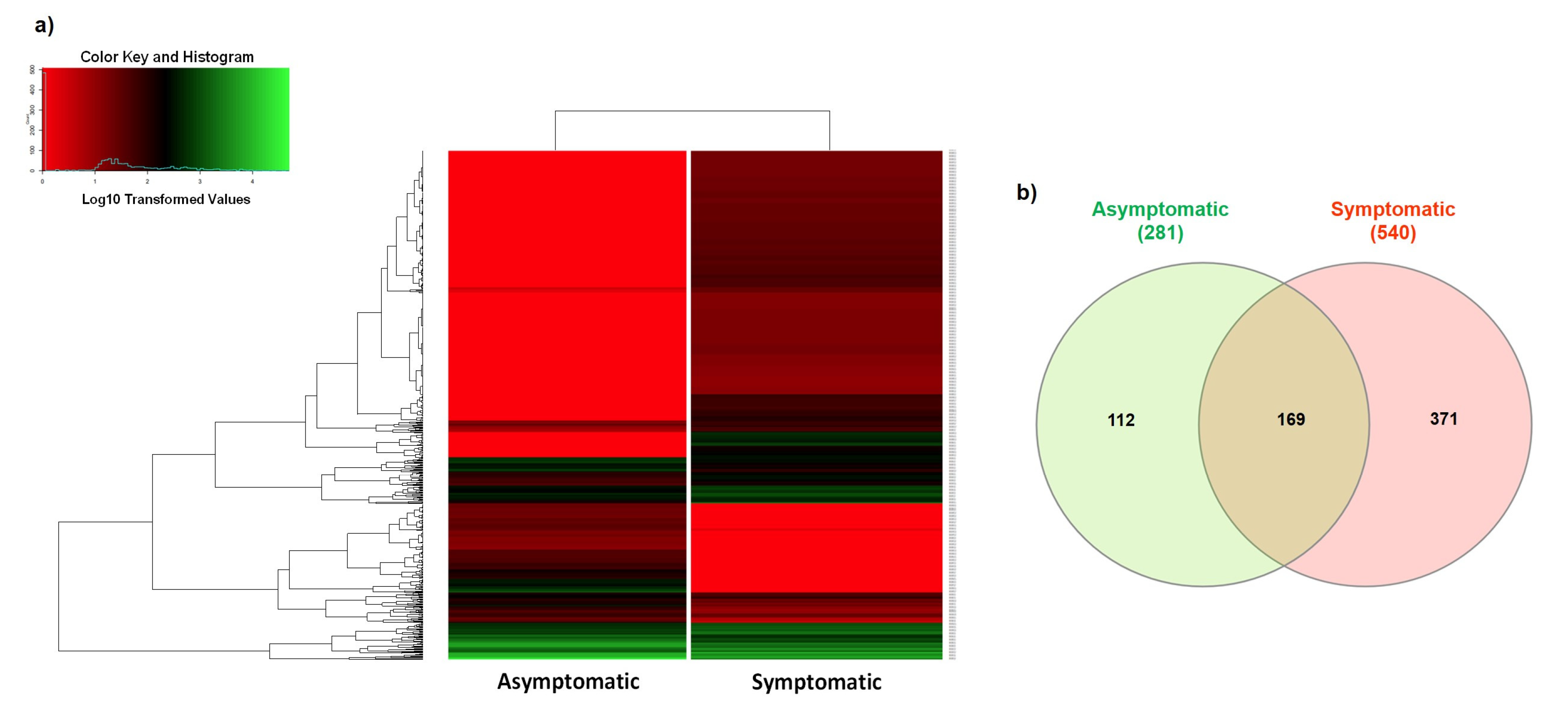
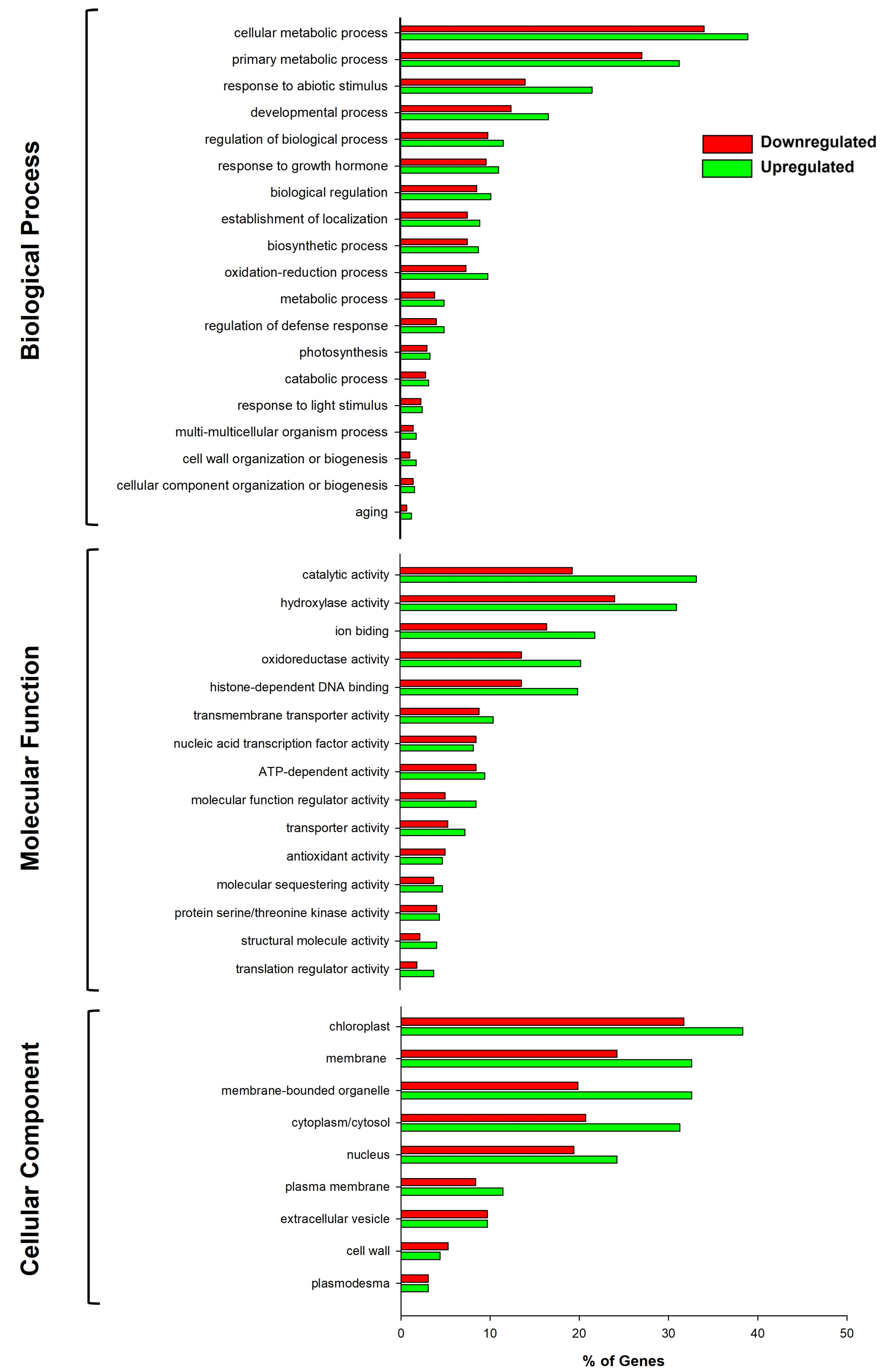
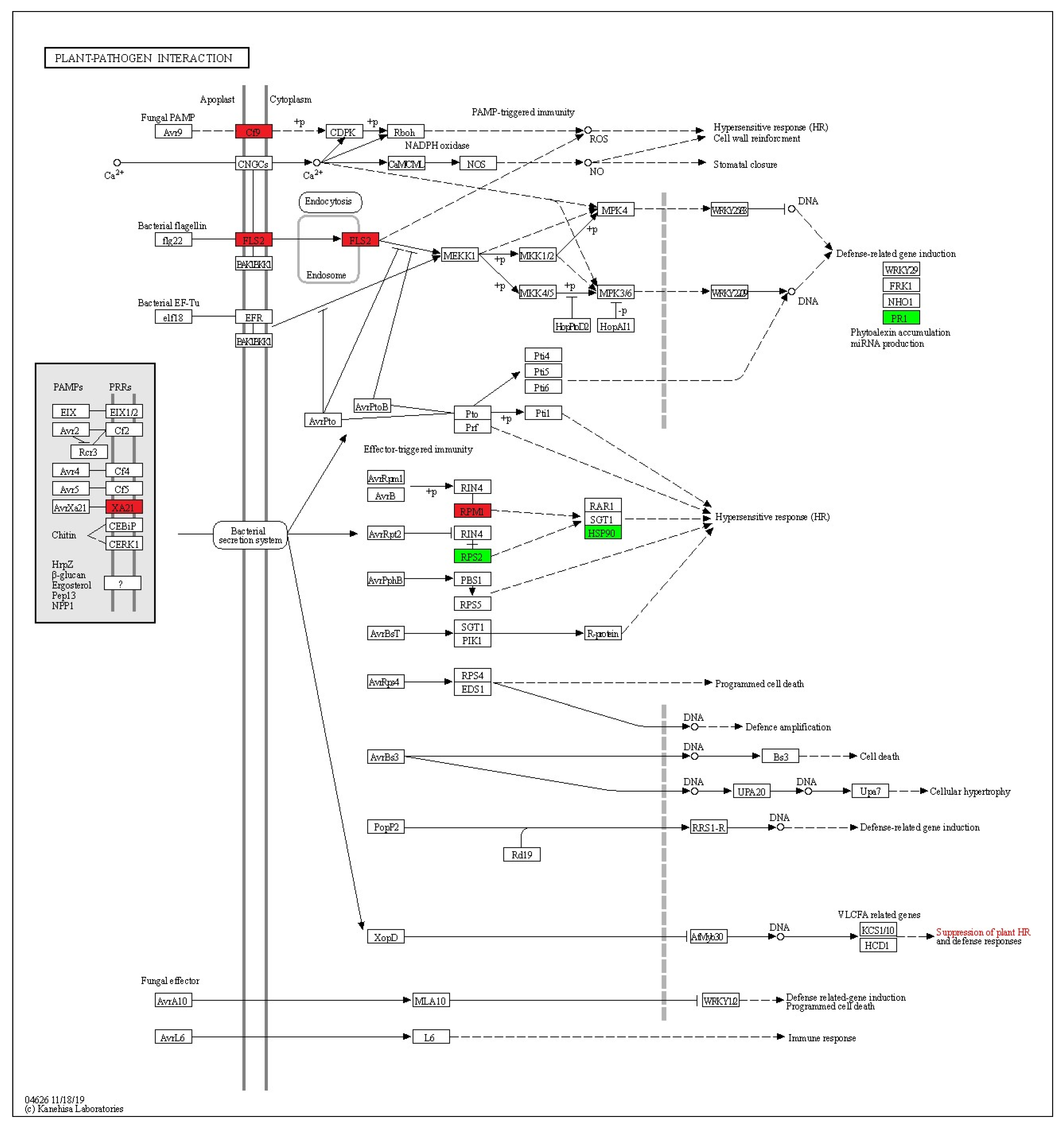
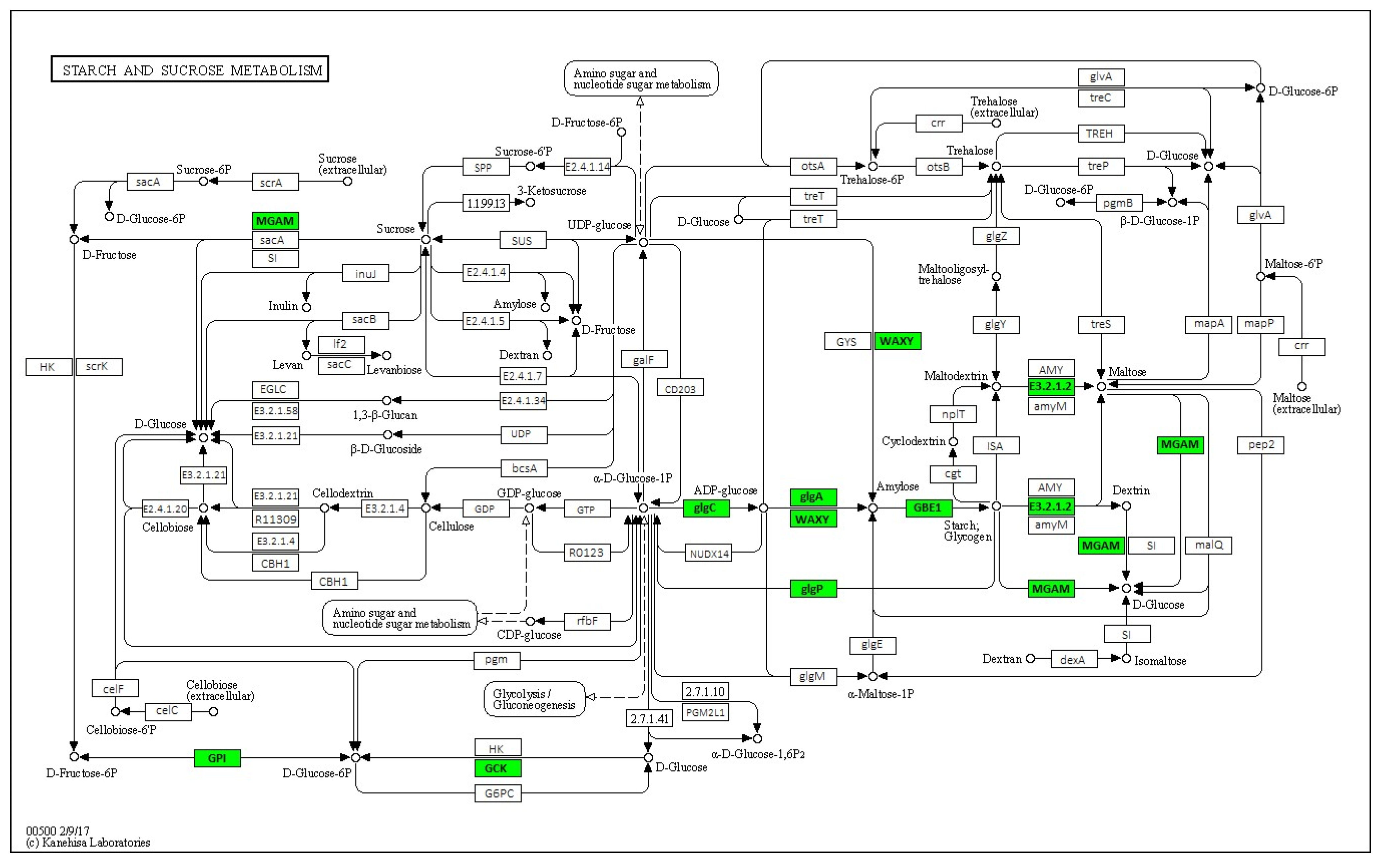
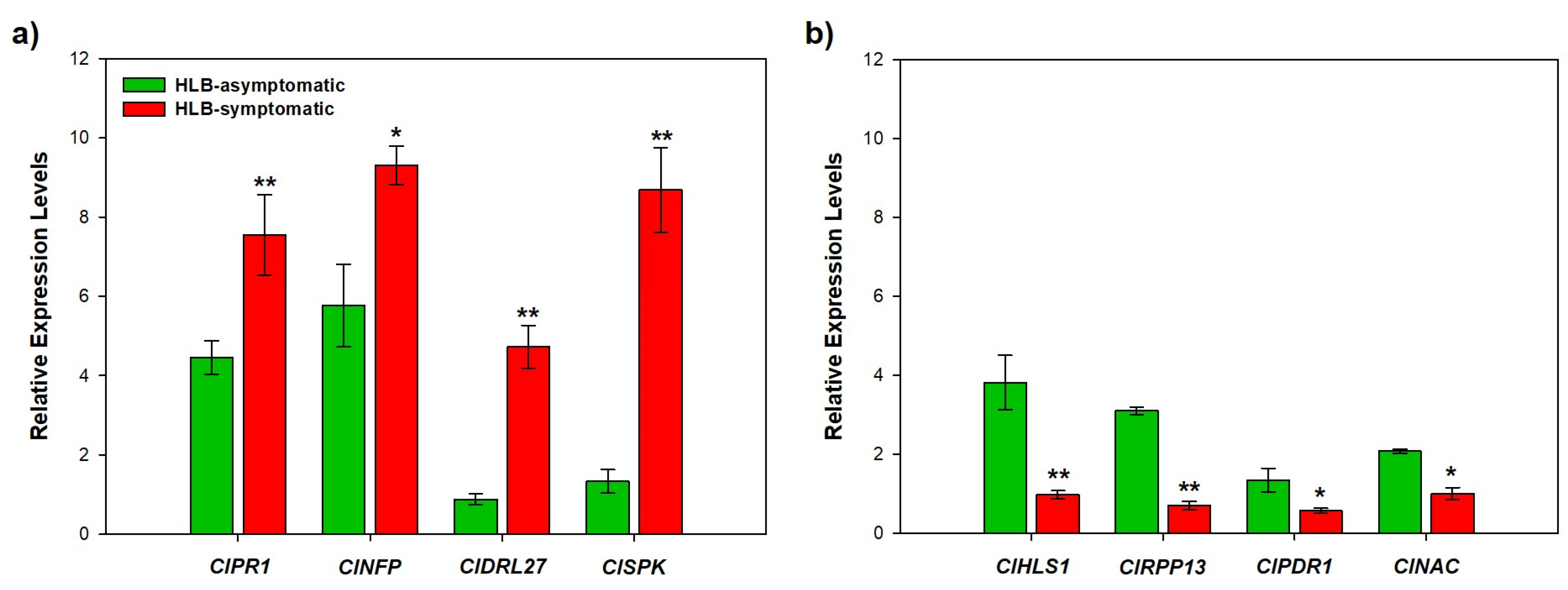
| ID Gene | Name | BLASTP_Hit | Pfam | Expression Asym | Expression Sym | Fold Change (Log2) | Regulated |
|---|---|---|---|---|---|---|---|
| DN91145_c0_g1_i1 | ClNFP | Serine/threonine receptor-like kinase NFP | Serine/threonine receptor-like kinase NFP | 0 | 80.80 | 8.60 | UP_Sym |
| DN14097_c0_g1_i1 | ClDRL27 | Disease resistance protein DRL27 | Disease resistance protein | 0 | 25.86 | 6.95 | UP_Sym |
| DN6810_c0_g2_i1 | ClSRK | G-type lectin S-receptor-like serine/threonine-protein kinase | G-type lectin S-receptor-like serine/threonine-protein kinase | 0 | 20.20 | 6.60 | UP_Sym |
| DN97321_c0_g1_i1 | ClCTR1 | Serine/threonine-protein kinase CTR1 | Serine/threonine-protein kinase | 0 | 16.85 | 6.34 | UP_Sym |
| DN135982_c0_g1_i1 | ClRLP46 | Receptor-like protein 46 RLP46 | Leucine Rich repeat | 0 | 14.95 | 6.16 | UP_Sym |
| DN20835_c0_g1_i1 | ClHSP90 | Heat shock protein 90-3 HSP | Hsp90 protein | 0 | 14.53 | 6.12 | UP_Sym |
| DN153599_c0_g1_i1 | ClRH56 | DEAD-box ATP-dependent RNA helicase 56 RH56 | Helicase conserved C-terminal domain | 0 | 12.89 | 5.95 | UP_Sym |
| DN9557_c0_g1_i1 | ClPR1 | Basic form of pathogenesis-related protein 1 PR1 | Cysteine-rich secretory protein family | 5.39 | 111.16 | 4.35 | UP_Sym |
| DN5017_c1_g1_i1 | ClWRKY23 | WRKY transcription factor 23 | WRKY DNA-binding domain | 12.57 | 54.84 | 2.11 | UP_Sym |
| DN112451_c0_g1_i1 | ClHSL1 | Receptor-like protein kinase HSL1 | Receptor-like protein | 288.52 | 0 | −10.80 | DOWN_Sym |
| DN27097_c0_g1_i1 | ClRPPL1 | Putative disease resistance RPP13-like protein | Putative disease resistance RPP13-like protein 1 | 167.82 | 0 | −10.02 | DOWN_Sym |
| DN14613_c0_g1_i1 | ClPDR1 | Pleiotropic drug resistance protein 1 | Pleiotropic drug resistance protein 1 | 161.81 | 0 | −9.97 | DOWN_Sym |
| DN92124_c0_g1_i1 | ClERF5 | Ethylene-responsive transcription factor 5 | ERF domain transcription factor | 87.10 | 0 | −9.08 | DOWN_Sym |
| DN8960_c0_g2_i1 | ClLAZ5 | Disease resistance protein LAZ5 | Leucine Rich Repeat | 78.15 | 0 | −8.92 | DOWN_Sym |
| DN180788_c0_g1_i1 | ClUCN | Serine/threonine-protein kinase UCN | Protein tyrosine and serine/threonine kinase | 68.64 | 0 | −8.73 | DOWN_Sym |
| DN19568_c0_g1_i2 | ClLRRC30 | Leucine Rich Repeat 30 | Leucine Rich Repeat | 61.24 | 0 | −8.57 | DOWN_Sym |
| DN13414_c0_g1_i2 | ClRLP54 | Receptor-like protein 54 RLP54 | Leucine Rich Repeat | 37.33 | 0 | −7.86 | DOWN_Sym |
| DN10515_c0_g1_i1 | ClNPR1 | NPR1_interact | NPR1 interacting | 132.26 | 17.86 | −3.22 | DOWN_Sym |
| DN18490_c0_g1_i1 | ClLRK71 | L-type lectin-domain containing receptor kinase VII.1 LRK71 | Legume lectin domain | 24.23 | 4.10 | −2.56 | DOWN_Sym |
| DN18226_c0_g1_i2 | ClSSL10 | Protein Strictosidine synthase-like 10 | Strictosidine synthase | 97.02 | 21.34 | −2.19 | DOWN_Sym |
| DN10036_c0_g2_i1 | ClNAC73 | NAC domain-containing protein 73 NAC73 | No apical meristem (NAM) protein | 101.89 | 23.28 | −2.13 | DOWN_Sym |
Disclaimer/Publisher’s Note: The statements, opinions and data contained in all publications are solely those of the individual author(s) and contributor(s) and not of MDPI and/or the editor(s). MDPI and/or the editor(s) disclaim responsibility for any injury to people or property resulting from any ideas, methods, instructions or products referred to in the content. |
© 2023 by the authors. Licensee MDPI, Basel, Switzerland. This article is an open access article distributed under the terms and conditions of the Creative Commons Attribution (CC BY) license (https://creativecommons.org/licenses/by/4.0/).
Share and Cite
Estrella-Maldonado, H.; González-Cruz, C.; Matilde-Hernández, C.; Adame-García, J.; Santamaría, J.M.; Santillán-Mendoza, R.; Flores-de la Rosa, F.R. Insights into the Molecular Basis of Huanglongbing Tolerance in Persian Lime (Citrus latifolia Tan.) through a Transcriptomic Approach. Int. J. Mol. Sci. 2023, 24, 7497. https://doi.org/10.3390/ijms24087497
Estrella-Maldonado H, González-Cruz C, Matilde-Hernández C, Adame-García J, Santamaría JM, Santillán-Mendoza R, Flores-de la Rosa FR. Insights into the Molecular Basis of Huanglongbing Tolerance in Persian Lime (Citrus latifolia Tan.) through a Transcriptomic Approach. International Journal of Molecular Sciences. 2023; 24(8):7497. https://doi.org/10.3390/ijms24087497
Chicago/Turabian StyleEstrella-Maldonado, Humberto, Carlos González-Cruz, Cristian Matilde-Hernández, Jacel Adame-García, Jorge M. Santamaría, Ricardo Santillán-Mendoza, and Felipe Roberto Flores-de la Rosa. 2023. "Insights into the Molecular Basis of Huanglongbing Tolerance in Persian Lime (Citrus latifolia Tan.) through a Transcriptomic Approach" International Journal of Molecular Sciences 24, no. 8: 7497. https://doi.org/10.3390/ijms24087497
APA StyleEstrella-Maldonado, H., González-Cruz, C., Matilde-Hernández, C., Adame-García, J., Santamaría, J. M., Santillán-Mendoza, R., & Flores-de la Rosa, F. R. (2023). Insights into the Molecular Basis of Huanglongbing Tolerance in Persian Lime (Citrus latifolia Tan.) through a Transcriptomic Approach. International Journal of Molecular Sciences, 24(8), 7497. https://doi.org/10.3390/ijms24087497






